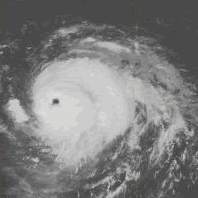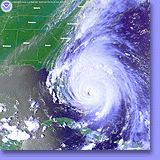 Thunderstorms
form over Africa and move west as a "tropical wave." The "Cape Verde"
storms that begin here may grow into the most violent of hurricanes.
Thunderstorms
form over Africa and move west as a "tropical wave." The "Cape Verde"
storms that begin here may grow into the most violent of hurricanes.
W H A T M A K E S A H U R R I C A N E ?
 Thunderstorms
form over Africa and move west as a "tropical wave." The "Cape Verde"
storms that begin here may grow into the most violent of hurricanes.
Thunderstorms
form over Africa and move west as a "tropical wave." The "Cape Verde"
storms that begin here may grow into the most violent of hurricanes.
A potential hurricane begins to grow as surface winds collide and force air higher in a region known as the Intertropical Convergence Zone (ITCZ). To feed a hurricane you need ocean waters warmer than 80 degrees and at least 200 ft deep so that cold water doesn't get mixed in and cool things down.
Warm, wet air rises: water vapor condenses into droplets, releasing latent heat. The heated air is lighter, resulting in an area of low pressure, and continues rising.
Higher up the rising air sucks in humid air from the upper atmosphere. This water vapor also becomes rain or ice, releasing still more energy. The trade winds blowing from Africa blow the storm westward.
At the top of the growing storm system, the rising air encounters colder air, at higher pressure, and spreads out. Earth's Coriolis forces cause the air to spiral out in a clockwise direction in the Northern Hemisphere (and counterclockwise in the South.)
Into this region of low pressure, more warm rushes in as strong winds, replacing the air that has already moved in, on and up. It's this repeated cycle of in, on and up that creates the violent, high speed winds that make some tropical storms into full-fledged hurricanes.
 As
the storm approaches the Americas, the Bermuda High (a region of high
pressure) shapes its future course. If the Bermuda High is strong, it keeps
the storm far south, steering it toward Florida or Mexico. If it's less strong,
it may turn north and move up and sometimes over the East Coast of the United
States. If the Bermuda High is even weaker, the storm will curve round and back
out over the cooler North Atlantic where it will lose strength and die out.
As
the storm approaches the Americas, the Bermuda High (a region of high
pressure) shapes its future course. If the Bermuda High is strong, it keeps
the storm far south, steering it toward Florida or Mexico. If it's less strong,
it may turn north and move up and sometimes over the East Coast of the United
States. If the Bermuda High is even weaker, the storm will curve round and back
out over the cooler North Atlantic where it will lose strength and die out.
As
a hurricane comes ashore it's usually water and not wind that's the most dangerous.
The storm drives as much as 20 feet of water before it, the "storm surge",
battering down buildings and carrying floods inland. But once a hurricane is
over land it's lost the fuel it needed to stay alive and grow, the heat and
humidity of the ocean, and the storm weakens. Even as it dies away, however,
high winds and heavy rains can bring great destruction.
|
WANT
TO KNOW MORE?
|
|||
| Glossary Links: Thunderstorms, Tropical Wave, Intertropical Convergence Zone , Latent Heat , Low Pressure, Trade Winds, High Pressure, Coriolis Forces, Tropical Storms, Bermuda High, Storm Surge, | |||
|
NSSL (Site Tour) |
ITCZ Bermuda High |
Hurricane Season |
Coriolis
Forces |
![]()